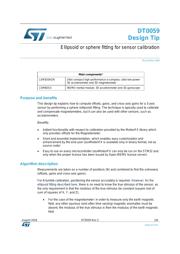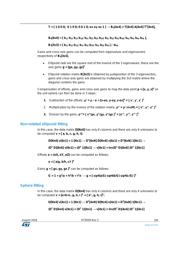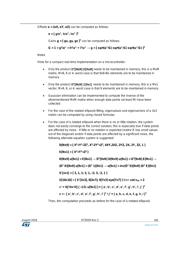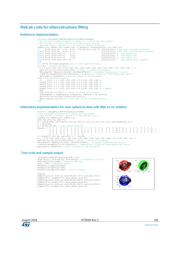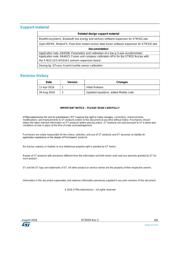Datasheet 搜索 > ST Microelectronics(意法半导体) > IIS2MDCTR 数据手册 > IIS2MDCTR 产品描述及参数 3/6 页

 器件3D模型
器件3D模型¥ 11.915
IIS2MDCTR 产品描述及参数 - ST Microelectronics(意法半导体)
制造商:
ST Microelectronics(意法半导体)
封装:
LGA-12
描述:
板机接口霍耳效应/磁性传感器 High accuracy, ultra-low-power ,3-axis digital output magnetometer
Pictures:
3D模型
符号图
焊盘图
引脚图
产品图
IIS2MDCTR数据手册
Page:
of 6 Go
若手册格式错乱,请下载阅览PDF原文件

August 2016
DT0059 Rev 2
3/6
www.st.com
T = [ 1 0 0 0; 0 1 0 0; 0 0 1 0; ox oy oz 1 ] → B
4
[4x4] = T[4x4] A[4x4] T
T
[4x4],
B
4
[4x4] = [ b
11
b
12
b
13
b
14
; b
21
b
22
b
23
b
24
; b
31
b
32
b
33
b
34
; b
41
b
42
b
43
b
44
],
B
3
[3x3] = [ b
11
b
12
b
13
; b
21
b
22
b
23
; b
31
b
32
b
33
] / -b
44
Gains and cross-axis gains can be computed from eigenvalues and eigenvectors
respectively of B
3
[3x3].
Ellipsoid radii are the square root of the inverse of the 3 eigenvalues; these are the
axis gains g = [gx, gy, gz]
T
Ellipsoid rotation matrix R[3x3] is obtained by juxtaposition of the 3 eigenvectors;
gains and cross-axis gains are obtained by multiplying the 3x3 matrix where the
diagonal contains the gains
Compensation of offsets, gains and cross-axis gains to map the data point p = [x, y, z]
T
on
the unit sphere can then be done in 3 steps:
1. Subtraction of the offsets, p’ = p - o = [x-ox, y-oy, z-oz]
T
= [ x’, y’, z’ ]
T
2. Multiplication by the inverse of the rotation matrix, p” = p’ inv(R) = [ x”, y”, z” ]
T
3. Division by the gains, p’”= [ x”/gx, y”/gy, z”/gz ]
T
= [x’”, y’”, z’” ]
T
Non-rotated ellipsoid fitting
In this case, the data matrix D[Nx6] has only 6 columns and there are only 6 unknowns to
be computed v = [ a, b, c, g, h, i]:
D[Nx6] v[6x1] = 1 [Nx1] → D
T
[6xN] D[Nx6] v[6x1] = D
T
[6xN] 1[Nx1] →
(D
T
D)[6x6] v[6x1] = (D
T
1)[6x1] → v[6x1] = inv(D
T
D)[6x6] (D
T
1)[6x1]
Offsets o = (oX, oY, oZ) can be computed as follows:
o = [ a/g, b/h, c/i ]
T
Gains g = [ gx, gy, gz ]
T
can be computed as follows:
G = 1 + g
2
/a + h
2
/b + i
2
/c → g = [ sqrt(a/G) sqrt(b/G) sqrt(c/G) ]
T
Sphere fitting
In this case, the data matrix D[Nx4] has only 4 columns and there are only 4 unknowns to
be computed v = [a+b+c, g, h, i ]
T
= [ a”, g, h, i]
T
:
D[Nx4] v[4x1] = 1 [Nx1] → D
T
[4xN] D[Nx4] v[4x1] = D
T
[4xN] 1[Nx1] →
(D
T
D)[4x4] v[4x1] = (D
T
1)[4x1] → v[4x1] = inv(D
T
D)[4x4] (D
T
1)[4x1]
器件 Datasheet 文档搜索
AiEMA 数据库涵盖高达 72,405,303 个元件的数据手册,每天更新 5,000 多个 PDF 文件
